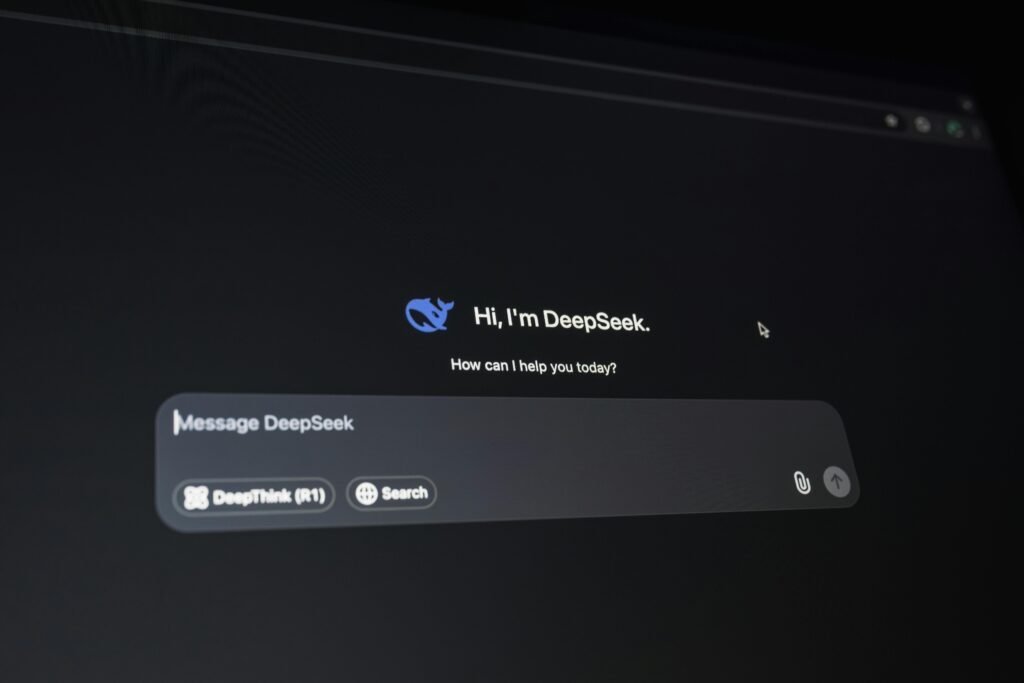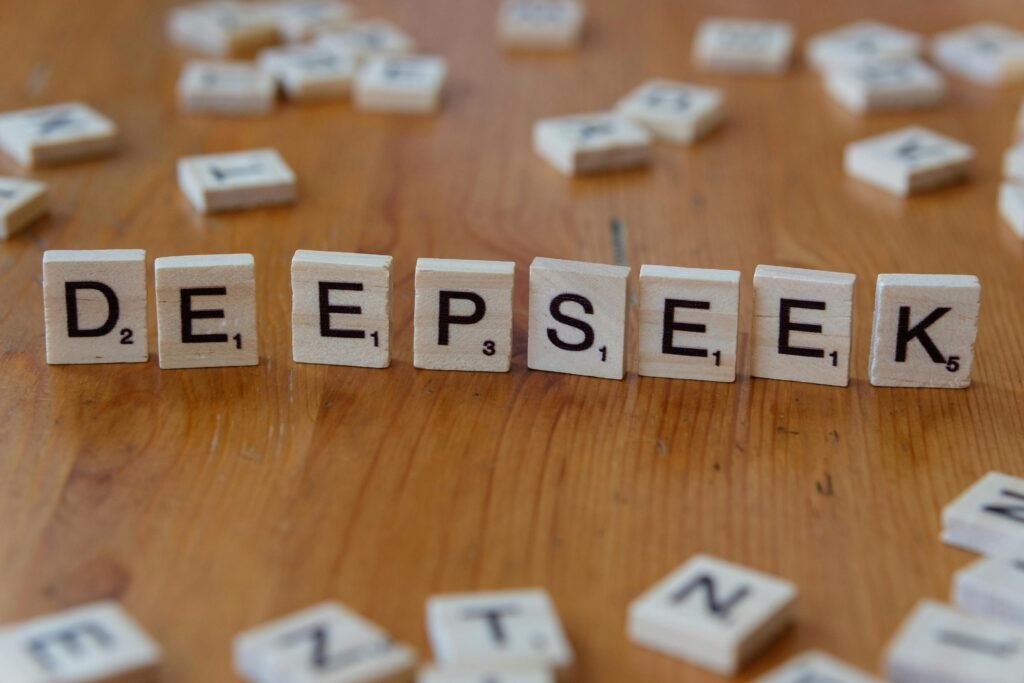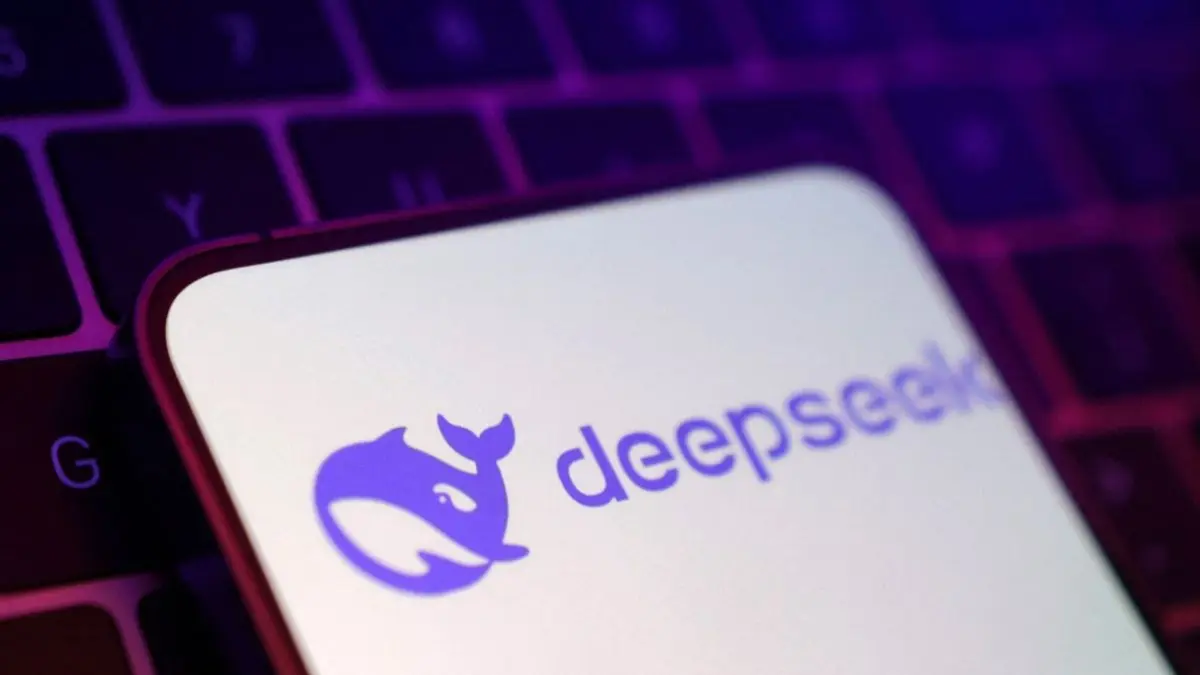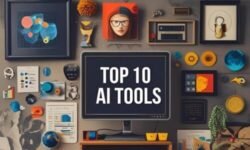Introduction to DeepSeek AI
Artificial Intelligence (AI) is no longer just a futuristic concept—it’s an everyday reality shaping the way we live, work, and interact. Among the many AI innovations in 2025, one platform has quickly captured global attention: DeepSeek AI. Positioned as a next-generation AI system, DeepSeek is redefining how businesses and individuals harness the power of machine learning, natural language processing, and automation.

What is DeepSeek AI?
DeepSeek AI is an advanced artificial intelligence platform designed to push beyond the limits of conventional AI models. Unlike traditional systems that focus on narrow applications, DeepSeek combines multi-modal intelligence, deep contextual understanding, and real-time adaptability. This means it can process text, voice, images, and structured data with near-human accuracy.
The goal of DeepSeek AI isn’t just to answer questions or perform automated tasks—it’s built to think, analyze, and adapt to complex scenarios. Whether it’s predicting financial markets, assisting in medical diagnoses, or creating human-like content, DeepSeek’s design emphasizes both precision and scalability.
The Rise of AI in 2025
Over the past decade, AI adoption has skyrocketed across every industry. From chatbots to self-driving cars, businesses and consumers have gradually embraced automation. However, 2025 represents a turning point: AI is no longer an optional tool—it’s an essential component of global progress.
DeepSeek AI enters this landscape at the perfect time. Its advanced learning algorithms are not only more powerful than previous models but also more accessible. Companies that once struggled with costly AI integrations now find DeepSeek to be a cost-effective, cloud-based solution that scales easily.
Why DeepSeek AI Stands Out
In a crowded AI market, what makes DeepSeek special? Three things:
- Contextual Intelligence – Unlike older AI systems that often provide generic responses, DeepSeek tailors its outputs based on context, tone, and intent.
- Multi-Domain Expertise – From healthcare to finance, DeepSeek isn’t confined to one field. Its ability to learn across industries makes it highly versatile.
- Human-Centric Design – DeepSeek focuses on human-AI collaboration rather than replacement. It enhances productivity without eliminating the human touch.
In short, DeepSeek AI represents a leap forward, positioning itself as both a technological breakthrough and a strategic business advantage.

History and Evolution of DeepSeek AI
The Founding Vision
DeepSeek AI was created with a mission to bridge the gap between human intelligence and machine intelligence. Unlike many early AI systems built solely for academic or experimental purposes, DeepSeek’s foundation was rooted in real-world application. The developers envisioned an AI that could be as intuitive as a human assistant, yet far more efficient when handling data-heavy tasks.
Its creators emphasized ethical AI development, ensuring the platform was transparent, explainable, and responsible. This human-first philosophy continues to influence how DeepSeek evolves, distinguishing it from models that prioritize raw power over usability.
Technological Breakthroughs Over Time
The journey of DeepSeek can be divided into three phases:
- Early Research (Pre-2023) – Initial prototypes focused on basic NLP models with limited applications.
- Scalable Deployment (2023–2024) – DeepSeek introduced cloud integration, allowing businesses to adopt AI without massive infrastructure costs.
- Next-Gen Intelligence (2025) – Today, DeepSeek features multi-modal learning, combining text, speech, image recognition, and predictive analytics into one unified system.
Each phase brought not only technical improvements but also practical solutions that made AI adoption easier for companies of all sizes.
Comparison with Other AI Models
While DeepSeek is often compared to OpenAI’s GPT, Google’s Gemini, and Anthropic’s Claude, it stands apart in key areas:
- Adaptability – DeepSeek trains faster on industry-specific data.
- Efficiency – Its lightweight infrastructure makes it cheaper to deploy.
- Accuracy – It delivers fewer hallucinations (incorrect outputs) compared to other large language models.
This positions DeepSeek not as a replacement, but as a competitor that raises industry standards.

Core Features of DeepSeek AI
Natural Language Processing (NLP) Capabilities
At the heart of DeepSeek AI is its powerful NLP engine. Unlike many models that struggle with context, DeepSeek excels in understanding tone, sentiment, and nuance. This makes it highly effective in:
- Conversational AI (chatbots, assistants)
- Content creation (blogs, reports, scripts)
- Sentiment analysis (customer feedback, social listening)
For businesses, this translates into better customer engagement and more human-like interactions.
Machine Learning & Deep Learning Algorithms
DeepSeek leverages a hybrid learning system, combining traditional machine learning with deep neural networks. This allows it to:
- Recognize complex patterns in large datasets
- Predict outcomes with high accuracy
- Continuously learn and adapt in real time
For example, in finance, DeepSeek can analyze millions of market signals and deliver predictive insights in seconds.
Real-Time Data Processing
One of DeepSeek’s strongest features is its ability to handle real-time data streams. This is especially valuable in:
- Stock trading (where milliseconds matter)
- Cybersecurity (detecting intrusions instantly)
- Healthcare monitoring (tracking patient vitals in real time)
The combination of speed and accuracy ensures businesses stay ahead of threats and opportunities.
Scalability and Cloud Integration
Unlike many bulky AI systems, DeepSeek was designed with scalability in mind. Whether a small startup or a multinational corporation, organizations can integrate DeepSeek seamlessly through cloud platforms.
This means companies no longer need massive in-house infrastructure—DeepSeek adapts to their scale. Its plug-and-play integrations also make adoption faster, reducing the time from implementation to results.

Applications of DeepSeek AI Across Industries
Healthcare and Medical Research
In healthcare, DeepSeek is revolutionizing patient care and research. Doctors use it to analyze medical images, predict patient outcomes, and suggest treatment plans. For researchers, DeepSeek accelerates drug discovery by simulating molecular interactions that would otherwise take years to study.
The result? Faster diagnoses, personalized medicine, and reduced costs.
Finance and Risk Management
Banks and financial institutions rely on DeepSeek for fraud detection, risk analysis, and algorithmic trading. Its ability to detect unusual patterns in transaction data makes it a powerful weapon against cybercrime.
Investors also benefit from DeepSeek’s predictive analytics, which provide insights into stock movements and market risks.
Education and Learning Enhancement
In education, DeepSeek acts as a personal tutor. It can adapt to a student’s learning style, provide tailored feedback, and even design custom learning paths. Universities also use it to streamline research and grading.
By making education more interactive and personalized, DeepSeek helps bridge the global learning gap.
E-commerce and Customer Experience
For online businesses, DeepSeek enhances the shopping experience. It powers product recommendations, chatbot support, and customer sentiment tracking. Retailers using DeepSeek see higher conversion rates and improved customer loyalty.
Cybersecurity and Threat Detection
DeepSeek is a game-changer in cybersecurity. By analyzing massive data streams in real time, it identifies and neutralizes threats before they escalate. From phishing attacks to ransomware, DeepSeek provides a proactive shield against digital dangers.

Benefits of Using DeepSeek AI
Accuracy and Efficiency
DeepSeek consistently delivers highly accurate outputs with minimal error rates. In industries like healthcare and finance, where mistakes can be costly, this level of reliability is invaluable.
Cost Reduction and Automation
By automating repetitive tasks, DeepSeek significantly lowers operational costs. Companies no longer need large teams for data entry, report generation, or customer support—AI handles it with ease.
Improved Decision-Making
With access to predictive analytics, businesses can make smarter, data-driven decisions. This reduces risks and opens new growth opportunities.
Personalized Experiences
Perhaps the most impactful benefit is personalization. From healthcare treatments tailored to individuals to shopping recommendations, DeepSeek ensures users feel seen and understood.
Challenges and Limitations of DeepSeek AI
Ethical Concerns and Bias
Even though DeepSeek AI is one of the most advanced systems today, it isn’t perfect. One of the main challenges is ethical bias. Like any AI, DeepSeek learns from massive datasets, which often contain human-generated information. Unfortunately, these datasets can carry inherent biases related to gender, race, culture, or socio-economic status.
For example, in healthcare, if the system is trained mostly on data from one demographic, its predictions may not be as accurate for another group. This raises the concern of fairness and inclusivity. The developers of DeepSeek are actively working to minimize such biases through balanced data training and continuous auditing, but it remains an ongoing challenge.
Another ethical issue is AI misuse. While DeepSeek was designed for productivity and problem-solving, in the wrong hands, it could be exploited for harmful purposes such as spreading misinformation or automating cyberattacks. This is why regulation and responsible usage are crucial.
Data Privacy and Security Risks
DeepSeek processes massive amounts of sensitive information—financial transactions, health records, personal conversations, and more. This raises serious data privacy concerns. Users and companies need assurance that their data is not only secure but also handled responsibly.
Although DeepSeek is built with advanced encryption and compliance frameworks, the risk of data leaks or unauthorized access can never be fully eliminated. Cybercriminals are constantly evolving, and AI-driven systems remain attractive targets.
Technical Limitations
Despite its strengths, DeepSeek still faces some technical hurdles:
- Energy Consumption: Training and running large AI models require immense computing power, which can impact sustainability.
- Dependency on Data Quality: Poor or incomplete data can lead to inaccurate results, no matter how advanced the system.
- Complex Integration: While DeepSeek is scalable, some organizations still struggle to integrate it seamlessly with outdated legacy systems.
These challenges don’t negate its value but highlight the importance of responsible AI governance and continuous improvement.

How DeepSeek AI is Shaping the Future of Work
AI as a Collaborator, Not a Replacement
One of the biggest myths about AI is that it will replace humans entirely. DeepSeek AI is proof that this isn’t the case. Instead of replacing jobs, it focuses on augmenting human capabilities.
Think of DeepSeek as a super assistant. It handles repetitive tasks, analyzes complex data, and provides intelligent recommendations, allowing humans to focus on creativity, strategy, and emotional intelligence. For example:
- In marketing, DeepSeek handles analytics, freeing teams to brainstorm creative campaigns.
- In healthcare, it manages data analysis, allowing doctors to spend more time with patients.
- In finance, it flags risks so human experts can focus on decision-making.
This collaborative model ensures that AI doesn’t eliminate jobs—it transforms them.
The Rise of Hybrid Workforces
We’re moving toward a world where human teams and AI systems work side by side. DeepSeek is at the forefront of this hybrid workforce revolution. Organizations using it see productivity gains because AI takes over time-consuming, repetitive tasks, while humans apply judgment and emotional intelligence.
This shift means future employees will need to develop new AI collaboration skills—understanding how to communicate with AI, interpret its outputs, and make informed decisions based on its insights.
Upskilling and Reskilling Opportunities
DeepSeek AI also creates opportunities for reskilling. As routine tasks are automated, workers can upgrade their skills in areas like:
- AI ethics and governance
- Data analysis and interpretation
- Creative problem-solving
Instead of making human skills obsolete, DeepSeek encourages a reskilling revolution, preparing the workforce for the jobs of tomorrow.

DeepSeek AI vs. Other AI Platforms
DeepSeek vs. OpenAI’s GPT Models
OpenAI’s GPT models are known for their advanced natural language generation. While they excel at producing human-like text, DeepSeek offers a broader range of multi-modal capabilities—processing not just text but also images, structured data, and real-time signals.
This makes DeepSeek more versatile in industries like healthcare and finance, where decisions rely on multiple data sources, not just language.
DeepSeek vs. Google Gemini
Google Gemini focuses heavily on scalability and integration within Google’s ecosystem. DeepSeek, on the other hand, emphasizes cross-platform adaptability, making it easier for businesses outside Google’s ecosystem to adopt and integrate.
Additionally, DeepSeek provides stronger customization features, allowing companies to fine-tune AI models for niche use cases.
DeepSeek vs. Anthropic Claude
Anthropic’s Claude AI prioritizes safety and ethical AI outputs. While DeepSeek also prioritizes ethics, it takes things further with real-time adaptability and industry-focused solutions. This balance between safety and performance makes DeepSeek attractive for enterprises seeking both reliability and innovation.
Conclusion of the Comparison
Each AI platform has its strengths, but DeepSeek stands out for its multi-domain expertise, real-time adaptability, and human-first design. For businesses seeking a comprehensive solution, DeepSeek often proves to be the most well-rounded option.

Future of DeepSeek AI: Predictions and Trends
Mainstream Adoption Across Industries
Over the next five years, DeepSeek AI is expected to become a mainstream enterprise solution. Small businesses, startups, and large corporations alike will leverage its scalability to integrate AI into daily operations.
This will likely lead to a world where AI-powered tools are as common as smartphones or the internet. Companies that fail to adopt may find themselves at a competitive disadvantage.
Integration with Emerging Technologies
DeepSeek will not exist in isolation—it will evolve alongside other cutting-edge technologies:
- IoT (Internet of Things) – Smart devices powered by DeepSeek will analyze and optimize data in real time.
- Blockchain – DeepSeek could enhance security by integrating blockchain-based verification.
- Augmented Reality (AR) and Virtual Reality (VR) – AI-driven immersive learning and customer experiences.
The convergence of AI, IoT, and AR/VR will create entirely new industries and opportunities.
Focus on Sustainable AI
One future trend is the push toward green AI. Since training large models consumes massive energy, DeepSeek’s developers are working on energy-efficient algorithms and cloud solutions to reduce environmental impact.
This sustainability focus will not only reduce costs but also make AI adoption more eco-friendly.
Greater Personalization in Everyday Life
As DeepSeek evolves, personalization will reach new heights. From healthcare treatments customized at the DNA level to learning systems tailored to individual students, AI will make life more personal, efficient, and human-centered.
How Businesses Can Implement DeepSeek AI
Step 1: Identifying Business Needs
The first step in adopting DeepSeek AI is understanding the company’s goals. Businesses should ask themselves:
- Do we want to improve customer service with chatbots?
- Are we aiming to automate data-heavy tasks?
- Do we need predictive analytics for better decision-making?
By defining clear objectives, organizations can avoid generic AI adoption and instead tailor DeepSeek to specific outcomes.
Step 2: Choosing the Right Deployment Model
DeepSeek offers different deployment options:
- Cloud-Based – Ideal for small to mid-sized companies that want flexibility and minimal upfront costs.
- On-Premises – Best for industries like healthcare or finance where data privacy and compliance are critical.
- Hybrid Models – A mix of both, giving businesses control over sensitive data while still benefiting from cloud scalability.
Choosing the right model depends on the balance between security, cost, and scalability.
Step 3: Data Preparation and Training
DeepSeek is only as good as the data it learns from. Businesses need to clean, organize, and label their datasets before training the model. High-quality data ensures more accurate predictions and outputs.
Additionally, companies can train DeepSeek on industry-specific datasets to fine-tune its capabilities. For instance, a law firm could provide case histories, while a hospital could upload anonymized medical records.
Step 4: Integration with Existing Systems
DeepSeek can integrate with CRM platforms, ERP software, and other business tools. This step is crucial for maximizing ROI since it allows AI insights to flow directly into everyday workflows.
For example, in e-commerce, integrating DeepSeek with CRM can automate product recommendations, while in finance, linking it with ERP systems helps detect anomalies in transactions.
Step 5: Monitoring and Continuous Improvement
AI is not a “set it and forget it” tool. Businesses must monitor DeepSeek’s performance and make adjustments regularly. This involves:
- Tracking accuracy rates
- Updating training data
- Testing ethical safeguards
- Optimizing response times
By maintaining a feedback loop, companies ensure that DeepSeek remains effective and aligned with their evolving needs.

Best Practices for Maximizing DeepSeek AI’s Potential
Prioritize Ethics and Transparency
One of the biggest mistakes companies make is treating AI as a “black box.” To build trust, businesses should prioritize explainable AI—where outputs are clear and justifiable. DeepSeek allows organizations to view how decisions are made, making it easier to comply with regulations and reassure customers.
Start Small, Then Scale
Instead of deploying DeepSeek across the entire organization immediately, businesses should start with pilot projects. For example, a retailer might first use it for chatbot support before expanding to supply chain optimization. This step-by-step approach reduces risk and builds confidence.
Train Employees to Work with AI
Human employees remain at the core of any AI implementation. Companies must train their staff to collaborate with DeepSeek effectively. This includes:
- Understanding AI limitations
- Interpreting AI-generated insights
- Overseeing automated workflows
When employees feel empowered to work alongside AI, adoption becomes smoother and more impactful.
Regularly Update Data and Models
Since the world is constantly changing, so is the data feeding AI systems. Businesses must ensure their DeepSeek models are retrained regularly to reflect new trends, behaviors, and risks. Outdated models can lead to inaccurate outputs and poor decision-making.

Case Studies: Real-World Success with DeepSeek AI
Case Study 1: Healthcare Diagnostics
A leading hospital adopted DeepSeek AI to assist with radiology image analysis. Traditionally, radiologists spent hours reviewing X-rays and MRIs. With DeepSeek, the hospital reduced diagnosis time by 40%, while maintaining high accuracy.
DeepSeek also helped predict disease progression, giving doctors more time to create personalized treatment plans. Patients received faster care, while doctors enjoyed reduced workloads.
Case Study 2: Financial Fraud Detection
A global bank integrated DeepSeek into its transaction monitoring systems. The AI detected unusual transaction patterns in real time, preventing fraudulent transfers before they were processed.
This resulted in millions saved annually, alongside improved customer trust. DeepSeek’s adaptability made it possible to update fraud detection rules continuously without human intervention.
Case Study 3: Personalized E-commerce
An online retailer used DeepSeek to enhance product recommendations. Instead of generic “people also bought” suggestions, DeepSeek analyzed browsing behavior, purchase history, and even customer sentiment from reviews.
The result? A 25% increase in conversion rates and stronger customer loyalty. Customers felt the brand “understood” them, thanks to the personalized shopping experience.
Case Study 4: Education and Online Learning
An ed-tech platform deployed DeepSeek to act as a virtual tutor. The AI adapted to each student’s learning pace, explained concepts in simple terms, and provided quizzes for practice.
Students reported higher engagement, while teachers used DeepSeek’s analytics to identify struggling learners early. This combination improved both academic performance and student satisfaction.

The Ethical Future of DeepSeek AI
AI Regulation and Compliance
As AI adoption grows, governments worldwide are introducing regulations to ensure safety and fairness. DeepSeek is designed to comply with frameworks like GDPR, HIPAA, and emerging AI-specific laws. Businesses using DeepSeek must also commit to these standards to avoid legal and reputational risks.
Promoting Human-Centric AI
DeepSeek’s philosophy is AI that empowers, not replaces. Its future development will continue focusing on enhancing human creativity, decision-making, and problem-solving. Rather than being a threat, DeepSeek positions itself as a partner for progress.
Building Trust Through Transparency
For AI to be widely accepted, users must trust it. DeepSeek ensures transparency by offering audit trails, explainable outputs, and bias detection tools. These safeguards make AI more accountable and reduce the risk of unintended consequences.

Conclusion
DeepSeek AI isn’t just another artificial intelligence platform—it’s a game-changer shaping the future of technology, business, and society. Its ability to deliver real-time insights, scale effortlessly, and work across industries makes it one of the most powerful AI solutions available today.
While challenges like ethics, data privacy, and bias remain, DeepSeek’s emphasis on human-centric design ensures that it supports rather than replaces human intelligence. From healthcare breakthroughs to fraud prevention and personalized learning, its applications are transforming industries worldwide.
Looking ahead, DeepSeek will play a central role in building a world where humans and machines collaborate seamlessly, unlocking levels of productivity, creativity, and personalization that were once unimaginable.
FAQs About DeepSeek AI
Frequently Asked Questions — DeepSeek AI
Got questions about DeepSeek AI? Browse the answers below — click any question to expand the full response.
DeepSeek stands out for its multi-modal capabilities (text, images, structured data, real-time signals), real-time adaptability, and strong emphasis on human-AI collaboration. Where some platforms focus mainly on language generation, DeepSeek blends contextual understanding, cross-domain learning, and industry customizability — making it a versatile solution for healthcare, finance, education and beyond.
Yes — DeepSeek is designed with security and compliance in mind. It supports encryption, audit trails, and frameworks for GDPR/HIPAA compliance. However, safe deployment also depends on implementation choices (on-prem vs cloud, data anonymization, access controls) and ongoing governance to keep privacy and security up to date.
No — DeepSeek is built to augment human abilities. It automates repetitive work and handles heavy data processing so people can focus on creativity, judgment, and relationship-driven tasks. That said, organizations should plan for reskilling and role evolution as responsibilities shift.
Small businesses can leverage DeepSeek for customer service automation (smart chatbots), personalized marketing (recommendations and segmentation), and lightweight data analysis — all without heavy upfront infrastructure. Cloud deployments and modular integrations allow SMBs to scale features based on budget and need.
The outlook is positive: expect mainstream adoption across industries, closer integration with IoT, blockchain, AR/VR, and a stronger focus on sustainable (energy-efficient) AI. DeepSeek is poised to deepen personalization in healthcare, education, and commerce while promoting human-centric, explainable AI practices.
For readers who want to dive deeper into the latest developments in artificial intelligence, we recommend exploring the resources available at Forbes AI Insights. This trusted platform provides regular updates, expert opinions, and industry news that complement the advancements we’ve discussed in DeepSeek AI. Staying informed through such reputable sources ensures you remain ahead of the curve as AI continues to evolve.




